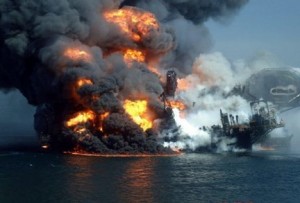Investigation: BP 'Focused On Financial Risks,' Not Systemic Problems, Before Oil Spill
 Today in Houston, the U.S. Chemical Safety Board will present the results of its investigation into the causes behind 2010′s devastating oil spill in the Gulf of Mexico.
Today in Houston, the U.S. Chemical Safety Board will present the results of its investigation into the causes behind 2010′s devastating oil spill in the Gulf of Mexico.The board found that BP failed to pay adequate attention to the safety of its rig systems, focusing instead on worker safety precautions like proper boots.
The board concluded that “BP applied lesser process safety standards” to contracted drilling rigs and that the company “dropped the ball on major accident hazards.” It also concluded that the disaster can be largely blamed on BP’s lack of “comprehensive hazard evaluation” for the Deepwater Horizon rig and the Macondo well.
Safety board managing director Daniel Horowitz told the Associated Press that BP was chronically short-sighted in its safety measures:
BP “did not conduct an effective comprehensive hazard evaluation of the major accident risks for the activities of the Deepwater Horizon rig or for the Macondo well” and accounted only for previous BP assets, not temporary ones like Deepwater Horizon. The Chemical Safety Board found that BP “focused on financial risks, not process safety risks” when drilling offshore.
The board’s presentation highlights the difference between worker safety measures and system safety measures, which are designed to make sure rigs are safe and not subject to leaks or combustion. The board found that BP and Transocean had an “inadequate” system in place.
Chemical Safety Board spokesperson Cheryl Mackenzie said the neglect bears an “eerie resemblance” to what the agency found in its investigation of the 2005 Texas City Refinery BP explosion, which killed 15 people. In that case, BP failed to ensure system safety by overlooking safety indicators like well kicks, flammable gas leaks and equipment damage.
“One of the main lessons coming out of the Texas City disaster was the need for a separate focus on process safety as opposed to personal safety,” board member Dr. Anthony Hopkins explains in a working paper, noting that the U.S. has weak regulations on rig safety indicators. Ian Whewell, another board member, said that the problem does not seem to be improving: “It is clear that performance indicators are in many companies still not being used as effectively as they should be to control major accident risks.”
The 2010 BP oil spill killed 11 people and released 5 million barrels of crude oil into the Gulf of Mexico. Though BP has spent millions on an ad campaign promoting their response to the spill, the work to identify the damage has just begun. In April, Al Jazeera reported that Gulf seafood is showing signs of drastic deformities from the spill, such as eyeless shrimp and fish riddled with lesions. Researchers have also said the oil spill contributed to a “perfect storm” for mass dolphin deaths in the Gulf.
You can return to the main Market News page, or press the Back button on your browser.

